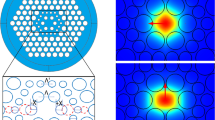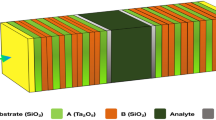Abstract
The sensing performance of a linearly tapered and apodized fiber Bragg grating is estimated and optimized. Coupled mode theory in association with the transfer matrix method is utilized to develop the reflectance formula of the proposed sensor. The reflectance spectra of linearly tapered fiber Bragg gratings are plotted for various apodization profiles. The sensitivity, detection accuracy, and quality parameter of proposed sensor are compared with standard fiber Bragg grating and linearly tapered fiber Bragg gratings-based sensors. It is found that the tapering in the waveguide along with apodization further improves the sensing performance of the sensor. Although the maximum sensitivity 489 nm/RIU is obtained in Hamming apodization and maximum left side lobe − 152 dB is obtained in Barthann apodization function, these apodizations show poor detection accuracy and quality parameters due to their larger value of full width at half maxima of sensing signal. The Bessel apodization function shows maximum detection accuracy (1366) and quality parameter (420/RIU) in our all-considered linearly tapered apodized structures. Followed by Bessel apodized sensor, the Blackman apodized sensor also shows higher detection accuracy (1340) and quality parameter (412/RIU). Therefore, these two apodization functions are recommended for biosensing applications in such a tapered structure.





Similar content being viewed by others
Availability of data and materials
The datasets used and/or analysed during the current study are available from the corresponding author on reasonable request.
References
Abushagur, A.A.G., Arsad, N., Elgaud, M.M., Bakar, A.A.A.: Development of a 1-dof force sensor prototype incorporating tapered fiber bragg grating for microsurgical instruments. IEEE Access. 7, 168520–168526 (2019). https://doi.org/10.1109/ACCESS.2019.2954914
Bekmurzayeva, A., Dukenbayev, K., Shaimerdenova, M., Bekniyazov, I., Ayupova, T., Sypabekova, M., Molardi, C., Tosi, D.: Etched fiber Bragg grating biosensor functionalized with aptamers for detection of thrombin. Sensors. (2018). https://doi.org/10.3390/s18124298
Chen, Y., Han, Q., Liu, T., Liu, F., Yao, Y.: Simultaneous measurement of refractive index and temperature using a cascaded fbg/droplet-like fiber structure. IEEE Sens. J. 15(11), 6432–6436 (2015). https://doi.org/10.1109/JSEN.2015.2450361
Chen, Q., Wang, D.N., Gao, F.: Simultaneous refractive index and temperature sensing based on a fiber surface waveguide and fiber bragg gratings. Opt. Lett. (2021). https://doi.org/10.1364/ol.419636
Dandapat, K., Kumar, I., Tripathi, S.M.: Ultra sensitive long period fiber gratings based sensor for detection of adulterator in ethanol. CLEO OSA (2018). https://doi.org/10.1364/cleo_at.2018.jw2a.170
Esposito, F., Srivastava, A., Iadicicco, A., Campopiano, S.: Multi-parameter sensor based on single long period grating in panda fiber for the simultaneous measurement of sri, temperature and strain. Opt. Laser Technol. 113, 198–203 (2018). https://doi.org/10.1016/j.optlastec.2018.12.022
Frazão, O., Martynkien, T., Baptista, J.M., Santos, J.L., Urbanczyk, W., Wojcik, J.: Optical refractometer based on a birefringent bragg grating written in an h-shaped fiber. Opt. Lett. (2009). https://doi.org/10.1364/ol.34.000076
Hu, W., Li, C., Cheng, S., Mumtaz, F., Du, C., Yang, M.: Etched multicore fiber bragg gratings for refractive index sensing with temperature in-line compensation. OSA Contin. (2020). https://doi.org/10.1364/osac.387019
Korganbayev, S., Sypabekova, M., Amantayeva, A., González-Vila, A., Caucheteur, C., Saccomandi, P., Tosi, D.: Optimization of cladding diameter for refractive index sensing in tilted fiber bragg gratings. Sensors. (2022). https://doi.org/10.3390/s22062259
Kuhne, J.F., Nadas, R.B., Inácio, P.L., Chiamenti, I., Kamikawachi, R.C., Kalinowski, H.J.: Refractive index sensitivity in etched fbg in the visible range. Proc. SPIE. (2017). https://doi.org/10.1117/12.2272227
Li, Y., Wang, X., Bao, X.: Sensitive acoustic vibration sensor using single-mode fiber tapers. Appl. Opt. 50(13), 1873–1878 (2011). https://doi.org/10.1364/AO.50.001873
Li, C., Ning, T., Li, J., Pei, L., Zhang, C., Zhang, C., Lin, H., Wen, X.: Simultaneous measurement of refractive index, strain, and temperature based on a four-core fiber combined with a fiber Bragg grating. Opt. Laser Technol. 90, 179–184 (2016). https://doi.org/10.1016/j.optlastec.2016.11.019
Liang, M., Fang, X., Song, Y., Li, S., Chen, N., Zhang, F.: Research on three-dimensional stress monitoring method of surrounding rock based on fbg sensing technology. Sensors. (2022). https://doi.org/10.3390/s22072624
Mihailov, S.J.: Fiber bragg grating sensors for harsh environments. Sensors. 12(2), 1898–1918 (2012). https://doi.org/10.3390/s120201898
Mishra, A.K., Mishra, S.K.: Infrared spr sensitivity enhancement using ITO/TiO2/silicon overlays. Europhysics Lett. (2015). https://doi.org/10.1209/0295-5075/112/10001
Mohammed, N.A., Ali, T.A., Aly, M.H.: Performance optimization of apodized fbg-based temperature sensors in single and quasi-distributed dwdm systems with new and different apodization profiles. AIP Adv. (2013). https://doi.org/10.1063/1.4859115
Oliveira, R.A., Cook, K., Canning, J., Pohl, A.: Controlling the properties of fiber bragg gratings by using acoustic waves. Opt. Infobase Conf. Pap. (2010). https://doi.org/10.1364/bgpp.2010.jtha48
Osuch, T., Markowski, K., Jędrzejewski, K.: Numerical model of tapered fiber bragg gratings for comprehensive analysis and optimization of their sensing and strain-induced tunable dispersion properties. Appl. Opt. 54(17), 5525–5533 (2015). https://doi.org/10.1364/ao.54.005525
Othonos, A.: Fiber bragg gratings. Rev. Sci. Instrum. 68(12), 4309–4341 (1997). https://doi.org/10.1063/1.1148392
Othonos, A., Kalli, K., Pureur, D., Mugnier, A.: Fibre bragg gratings. Springer Ser. Opt. Sci. 123, 189–269 (2006). https://doi.org/10.1007/3-540-31770-8_6
Palumbo, G., Tosi, D., Iadicicco, A., Campopiano, S.: Analysis and design of chirped fiber bragg grating for temperature sensing for possible biomedical applications. IEEE Photonics J. 10(3), 1–15 (2018). https://doi.org/10.1109/JPHOT.2018.2829623
Rani, S., Haider, S., Bukhari, S.H.R., Zaidi, S.A.A., Huda, A.B.: Performance optimization of apodized fbg biomedical sensor for variation in temperature and presence of noise. IEEJ Trans. Electr. Electron. Eng. (2022). https://doi.org/10.1002/tee.23573
Riza, M.A., Go, Y.I., Harun, S.W., Maier, R.R.J.: Fbg sensors for environmental and biochemical applications—a review. IEEE Sens. J. 20(14), 7614–7627 (2020). https://doi.org/10.1109/JSEN.2020.2982446
Rumadi, Syahriar, A., Astharini, D., Lubis, A.H.: The effects of apodization profile on uniform fiber bragg gratings. In: 9th International Conference on Telecommunication Systems Services and Applications (TSSA). (2015). https://doi.org/10.1109/TSSA.2015.7440430
Sahota, J.K., Gupta, N., Dhawan, D.: Fiber bragg grating sensors for monitoring of physical parameters: a comprehensive review. Opt. Eng. (2020). https://doi.org/10.1117/1.oe.59.6.060901
Singh, Y., Ansari, M.T.I., Raghuwanshi, S.K.: Design and development of titanium dioxide (TiO2)-Coated efbg sensor for the detection of petrochemicals adulteration. IEEE Trans. Instrum. Meas. (2021). https://doi.org/10.1109/TIM.2021.3053985
Ugale, S.P., Mishra, V.: Optimization of fiber bragg grating length for maximum reflectivity. Int. J. Eng. Sci. Technol. 2(9), 4463–4468 (2011). https://doi.org/10.1109/ICCSP.2011.5739375
Zhang, W., Zhu, L., Dong, M., Lou, X., Liu, F.: A temperature fiber sensor based on tapered fiber bragg grating fabricated by femtosecond laser. Appl. Sci. (2018). https://doi.org/10.3390/app8122616
Zhang, Y., Pu, S., Li, Y., Hao, Z., Li, D., Yan, S., Yuan, M., Zhang, C.: Magnetic field and temperature dual-parameter sensor based on nonadiabatic tapered microfiber cascaded with fbg. IEEE Access. 10, 15478–15486 (2022). https://doi.org/10.1109/ACCESS.2022.3148211
Acknowledgements
The author Souryadipta Maiti is thankful to DST-INSPIRE (Department of Science and Technology, Government of India, New Delhi) for providing fellowship for pursuing this work respectively. We also acknowledge support from the Institutions of Eminence (IoE) BHU Grant Scheme No. 6031.
Funding
Authors are also acknowledged support from the Institutions of Eminence (IoE), Banaras Hindu University, Grant scheme No. 6031.
Author information
Authors and Affiliations
Contributions
SM has done the simulation work of the device structure and also developed the computational framework. SM and SP preparing the final draft. VS has devised the idea and helped while preparing the final draft and supervised.
Corresponding author
Ethics declarations
Conflict of interest
The authors declare that they have no conflicts of interest.
Human and animals rights
This article does not contain any studies involving animals or human participants performed by any of the authors.
Consent to participate
Not Applicable.
Consent for publication
Not Applicable.
Additional information
Publisher's Note
Springer Nature remains neutral with regard to jurisdictional claims in published maps and institutional affiliations.
Rights and permissions
Springer Nature or its licensor (e.g. a society or other partner) holds exclusive rights to this article under a publishing agreement with the author(s) or other rightsholder(s); author self-archiving of the accepted manuscript version of this article is solely governed by the terms of such publishing agreement and applicable law.
About this article
Cite this article
Maiti, S., Prakash, S. & Singh, V. Sensing performance of apodized fiber Bragg gratings having linearly tapered profile. Opt Quant Electron 55, 624 (2023). https://doi.org/10.1007/s11082-023-04888-5
Received:
Accepted:
Published:
DOI: https://doi.org/10.1007/s11082-023-04888-5




